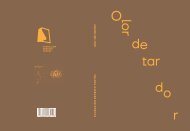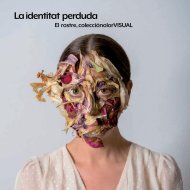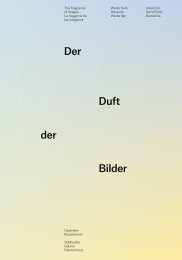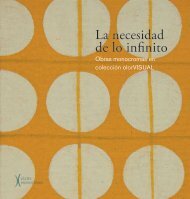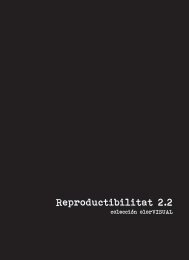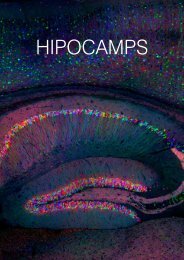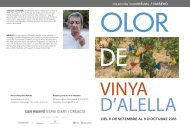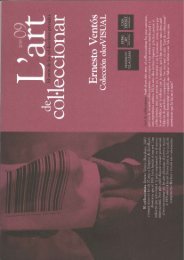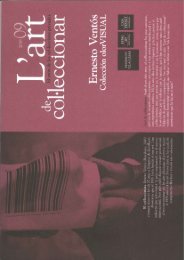Create successful ePaper yourself
Turn your PDF publications into a flip-book with our unique Google optimized e-Paper software.
to intersect itself lightly with the wall while suggesting the other part. Its form<br />
is organic, fluid and insinuates movement and a lack of gravity. It is painted in<br />
a gentle and total degradation that starts with an intense magenta purple that<br />
saturates itself till it reaches white. This emanation of form and color dilates into<br />
nothingness to make evident that it comes to be an infinitesimal part of the Whole.<br />
Juan Luis Moraza<br />
Carbon-14, Louis XIV and Ka; the sun god, the Sun King, and dating by<br />
the persistence of cosmic radioactivity … authority legitimated in the past,<br />
in necessity, or in inevitability. The acrostic is simple. What is hidden in the<br />
sun mask is the mask of an imposture, the tragicomic sign of the farce (ever<br />
greater) of a god, of a king, of a law: the clan of the circle: the circus of the<br />
master, the institution of the supposed necessity of a caprice, of a particularity.<br />
In this universe where the limbs are verse, it’s all about everything but<br />
indifference. In fact, there is nothing more evaluative than smell: each one is a<br />
judgement, and its extravagant precision convenes an ethics of the intrinsic and<br />
the alien. The acronym KKK thus relates the linkages between the bubbles,<br />
between the heliocentric systems of each nose. A star chart gives the relative<br />
position of the planets of our solar system for the time and place of birth of one<br />
of those nasal appendages that configure the transition from the sublime to the<br />
ridiculous, and make it reversible: the satires of Swift and Orwell embody a more<br />
profound vision than a whole library of social anthropology books.<br />
The nose is at the centre of the universe, and of Classicist heliocentrism: the<br />
centrality of smell, by means of a reactive formation that appeals to the visible. Like<br />
the hands, the nose deals with invisible objects, it notes the heat, the way everything<br />
trembles, it walks the path of the space. But unlike the gaze, which touches from a<br />
distance, holding the other at bay, smell makes the other present in every breath. This<br />
is what is unbearable for classicism, which fantasizes about a transcendental ethics,<br />
about the beauty of indifference, about a deodorant gaze. Classicism inflates a whole<br />
reactive bubble in its effort to overcome the stench of the alien, unable to avoid, with<br />
each breath, the silent touch of a sense dismissed as minor, animal. This is why it has<br />
traditionally thought of intuition as foresight, when it is something that has nothing<br />
to do with seeing. It is rather smell, touch sensed, not a vision of what has yet to be<br />
seen. Those who look are accustomed to a distant, unattainable world. Images speak<br />
remotely, and even of the remote. Smell dwells in the immediate, but also in the depth<br />
of air that speaks of the remote in a way that is not remote. Aura exists in smell.<br />
But in addition to its sensory properties, the nasal appendage is also the essence of<br />
the mask. Considered an ‘appendage’ it is defined from the outset as a supplement,<br />
as an accessory of the face that declares its substantial character. In effect, this<br />
appendage it what creates most contact, what is most immediate, what should not be<br />
stuck any old where. This mime of sensitivity has all the qualifications to be the object<br />
par excellence. We are dealing with an obstacle, with the evidence of the obstacle; but<br />
also with a lapse and an identification: it constitutes the surface of a return, a loop.<br />
The circus of consciousness in which the anonymous is the subject. As an appendage,<br />
the nasal is at once self and non-self. You are your nose, but not entirely; and this<br />
contradictory pertinence among parts and whole has made the nose a complement:<br />
face and mask, body and antibody destined never to come into contact without<br />
fear of total disintegration. Red from cold or heat, from shame or shamelessness,<br />
from emotion or from alcohol, the clown’s nose essentializes humanism by<br />
turning weaknesses into prerogatives, perhaps not assented to, but consensual.<br />
The pathetic is the clown become censor, executor. If we contemplate the crowd<br />
141




